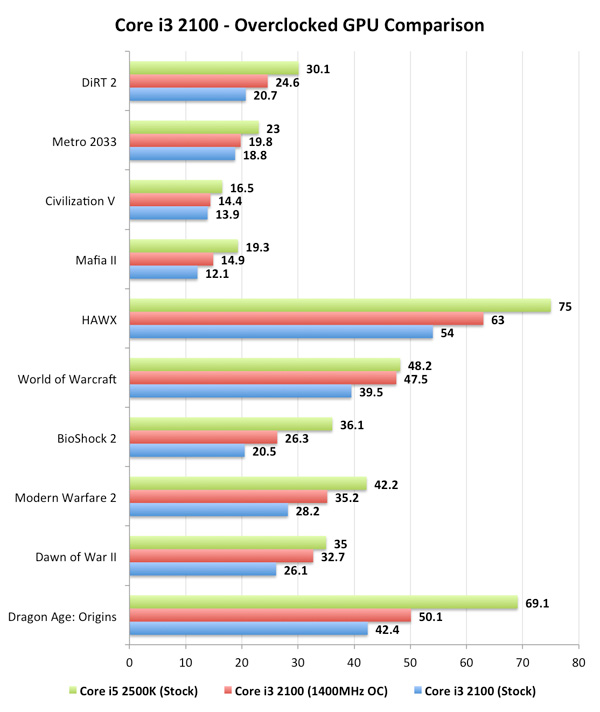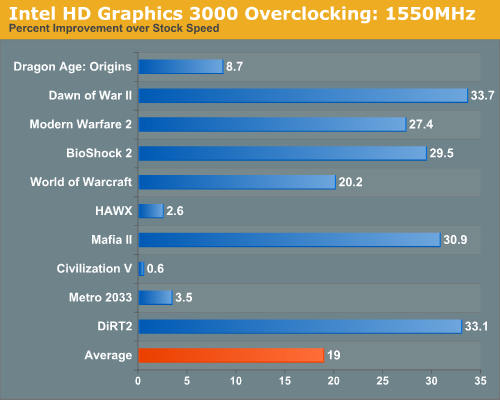The Sandy Bridge Review: Intel Core i7-2600K, i5-2500K and Core i3-2100 Tested
by Anand Lal Shimpi on January 3, 2011 12:01 AM ESTOverclocking Intel's HD Graphics
The base clock of both Intel's HD Graphics 2000 and 3000 on desktop SKUs is 850MHz. Thankfully, Intel's 32nm process allows for much headroom in both the CPU and GPU for overclocking. There are no clock locks or K-series parts to worry about when it comes to GPU overclocking; everything is unlocked. I started by trying to see how far I could push the Core i3-2100's HD Graphics 2000.
While I could get into Windows and run games at up to 1.6GHz, I needed to back down to 1.4GHz to maintain stability across all of our tests. That's a 64.7% overclock:

In some cases (Civilization V, WoW, Dawn of War II), the overclocked HD Graphics 2000 was enough to bring the 6 EU part close to the performance of the 3000 model. For the most part however the overclock just helped the Core i3-2100 perform halfway between it and the Core i5-2500K.
I tried the same experiment with the Core i5-2500K. While there's no chance it could catch up to a Radeon HD 5570, I managed to overclock my 2500K to 1.55GHz (the GPU clock can be adjusted in 50MHz increments):

The 82.4% increase in clock speed resulted in anywhere from a 0.6% to 33.7% increase in performance. While that's not terrible, it's also not that great. It looks like we're fairly memory bandwidth constrained here.










283 Comments
View All Comments
ac2 - Tuesday, January 4, 2011 - link
Oh yes and another-bloody-socket-thank-you-so-much...Lets not forget that the only reason Intel can get away with all this is that AMD have been off their game for a while now..
Wonder if ARM will be the next one to give Intel the occasional kick it needs to be a bit more customer friendly...
Hrel - Tuesday, January 4, 2011 - link
The HD5670 can be had for 65 bucks, so why include a 70 dollar 5570? illogical.Taft12 - Tuesday, January 4, 2011 - link
He's talking about the general online price across a variety of sites and OEMs (Sapphire, Asus, Palit, etc) not a one-off MIR-inclusive price that can be found only by the obsessive.kevith - Tuesday, January 4, 2011 - link
Man, this is awesome, my wallet is trying to hide, but it won't do it any good...I took the jump to AMD when Phenom II arrived, a friend of mine bought my C2D E7400 system, and already then I regretted when I was done building. There's no two ways about it, Intel systems - if they aren't the absolute low-end - runs so much smoother.
Which seems to be the case again, even at a reasonable price.
There's one thing about the review I don't really understand: "...Another Anandtech editor put it this way: You get the same performance at a lower price..."
Has he read the review?
As far as I can see, you get pretty much more performance at a lower price.
xsilver - Tuesday, January 4, 2011 - link
Is there going to be a memory scaling test for sandy bridge?eg. how much of a performance gap with ddr1333 ram vs ddr2000
also does sandy bridge's gpu allow for multi monitor setups? what about when stacked with a discrete gpu?
RicowSQL - Tuesday, January 4, 2011 - link
Hey guys, two things i'm missing from the SB reviews over the web:1) How well does the new IMC scales to memory clocks? I guess it's a matter of time until someone performs a in-depth analysis on that matter, but i'm particularly interested on that...
2) Adobe's Flash decoding can take advantage of Intel IGPs acceleration through Clear Video technology. Will it work in the new HD2000/3000 series as well?
ibudic1 - Tuesday, January 4, 2011 - link
But Why not VS 2010?Taft12 - Tuesday, January 4, 2011 - link
Same reason it takes a while for AT to provide comparisons of the latest games - it takes an eternity to run a benchmark on all CPUs going back a couple generations.Taft12 - Tuesday, January 4, 2011 - link
I think this might be an error in your chart -- the last one on page 3 shows a Y for the i3-2100 in the AES-NI column. I would love to have this feature on an i3 CPU, but the following paragraph states "Intel also uses AES-NI as a reason to force users away from the i3 and towards the i5" which leads me to believe that i3 doesn't have said feature.Please let me know if I'm wrong so I can get my pre-order in!!!
nedjinski - Tuesday, January 4, 2011 - link
Please comment on the Sandy Bridge / DRM 'controversy'.Thanks.